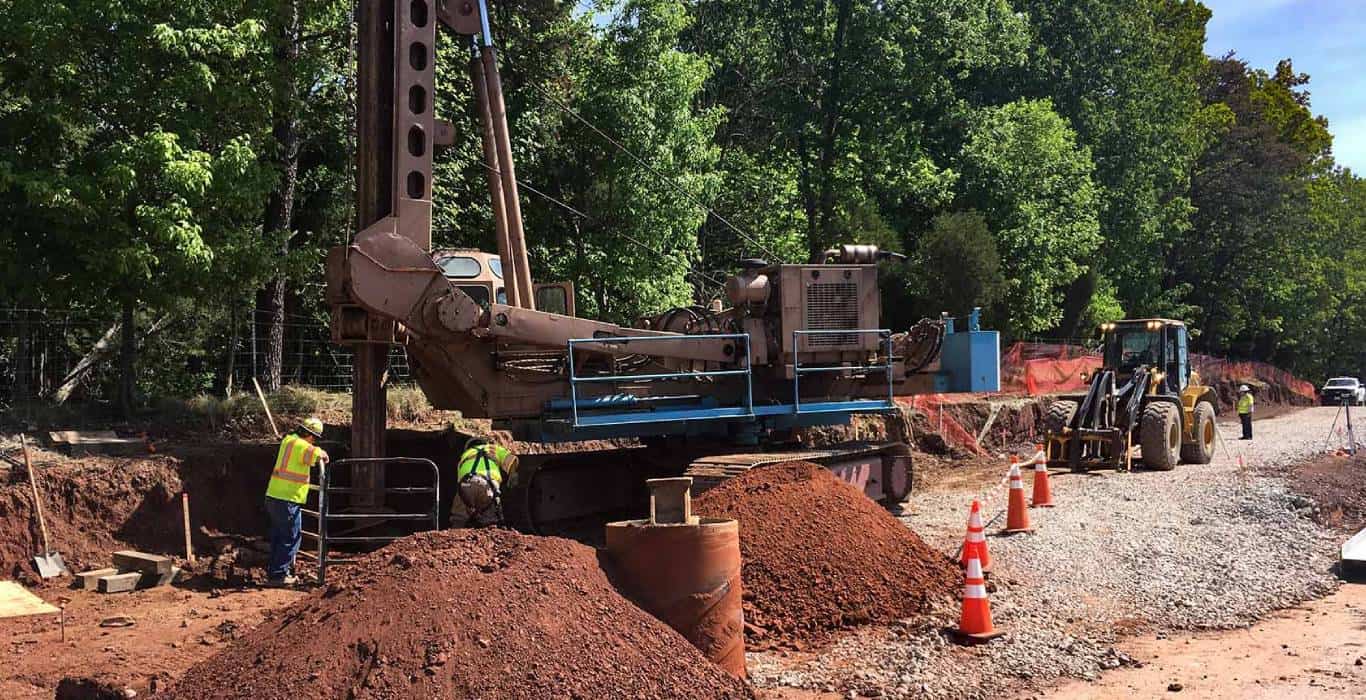A secant pile wall is a deep foundation that provides lateral support and prevents soil movement. It is made up of a series of interlocking, overlapping piles that are constructed by drilling into the ground. Piles are typically made of reinforced concrete and are cylindrical in shape.
The term “secant” refers to the interlocking arrangement of the piles. The primary piles (also called male piles) are constructed first. The secondary (female) piles are then constructed between the primary piles. The piles are cut into each other at an angle, which creates a continuous wall that can resist lateral loads.
Secant pile walls are often used to support excavations, stabilise slopes, and prevent erosion. They are also used in a variety of other applications, such as the construction of basements, tunnels, and bridges. Be with me throughout this guide to learn more about the topic.
Different Types of Secant Pile Walls
Secant pile walls can have different compositions (so the types) for the primary and secondary piles, resulting in various combinations: hard/soft, hard/firm, or hard/hard.
Hard/soft
In the hard/soft composition, the primary piles are made of a “soft” cement-bentonite mix, typically with a strength of 1 N/mm2. These primary piles are usually unreinforced but do not provide complete water-tightness.
Hard/firm
For the hard/firm composition, the primary piles are constructed using either weak mix concrete or full-strength mix concrete, typically with a strength of 10 N/mm2. A reinforced concrete lining may be necessary if the secant pile wall is intended for permanent works.
Hard/hard
Like hard/firm, the hard/hard composition utilises primary piles with higher-strength concrete, which may also be reinforced. This composition offers a substitute for diaphragm wall construction.

Application of Secant Pile Walls
Secant pile walls are a versatile and effective type of retaining wall that can be used in various applications. They are strong, watertight, and easy to install, making them favoured for many projects. Here are the common applications of secant pile walls.
Slope stabilisation
Secant pile walls can be used to stabilise slopes prone to erosion or landslides. The interlocking piles create a strong and continuous wall that can resist the force of gravity and water.
Excavation support
Secant pile walls are considered excellent for supporting excavations, such as constructing basements, tunnels, and bridges. The walls provide lateral support to the soil, preventing it from collapsing.
Bulkhead support
Secant pile walls can be employed to support bulkheads, walls built to prevent water from entering an area. The walls create a watertight barrier to keep water out of sensitive areas, such as basements and tunnels.
Water cut off
Secant pile walls can be used to create a water cut-off, which is a barrier that prevents water from flowing through an area. The walls are constructed so there are no gaps between the piles, creating a continuous watertight barrier.
Construction Process of Secant Pile Walls
The construction process of secant piles involves several steps to create overlapping piles and achieve the desired water tightness. Here is a thorough, step-by-step explanation of the process:
Excavation and Site Preparation
The construction site is prepared by excavating where the secant pile wall will be installed. The excavation is typically carried out to the required depth and width, taking into account the design specifications.
Primary Pile Installation
The construction begins by installing the primary piles, also known as female piles. These piles are typically unreinforced and can be constructed using materials such as cement, bentonite, or weak concrete. The primary piles are drilled into the ground at specific intervals, leaving gaps between them.
Secondary Pile Installation
Once the primary piles are in place, the secondary piles, also called male piles, are installed. The secondary piles are reinforced and are designed to interlock with the primary piles.
They are carved into either side of the primary piles, forming a steady and impervious structure in a secant pattern. The secondary piles can be installed using rebar cages, I-beams, W beams, or H beams to enhance their strength and stability.

Anchoring or Strutting (Optional)
When tight deflection criteria are required, the secant pile walls can be further reinforced by incorporating anchors or a strutting system. These additional support measures provide temporary or permanent retention to stabilise the walls.
Pile Spacing and Overlap
The spacing between the piles in the secant wall is typically around 0.8 to 0.9 times the diameter of the piles. This spacing is crucial to achieve the desired structural integrity. The overlap between the primary and secondary piles is usually around 3 inches, ensuring a close and interlocking connection between the piles.
Advantages of Secant Pile Walls
- Greater construction alignment flexibility.
- Higher stiffness compared to sheet piles.
- Suitable for challenging ground conditions.
- Quieter construction process.
- Eliminates the need for timber lagging.
Disadvantages of Secant Pile Walls
- Complete waterproofing at joints is difficult to achieve.
- Achieving verticality tolerances in deep piles can be challenging.
- Higher cost compared to sheet pile walls.



